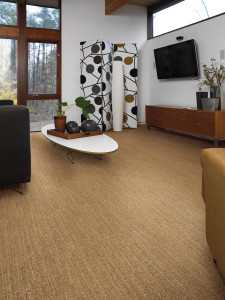There are different types of carpet, different fibers make up different styles and feels of carpet. Even though some carpets are comprised of blends, the majority are made totally of one of the four basic carpet fibers, as follow:
Nylon Carpets

Since the early 1960’s, nylon fiber has been the most frequently used type. In general performance features, nylon fiber is the most versatile among all types, providing exceptional flexibility in making a variety of styles of carpet. Nylon is available in an extensive selection of both loop pile and cut pile styles. It’s resilient, durable, and amenable to dyeing for uniformity and versatility of color; many innovative nylon yarn systems are extremely soft as well. Although not naturally resistant to stains, most carpets made of nylon fiber have a stain-resist treatment feature for defense against household stains and spills.
Polyester (PET) Carpets
Polyester carpet fibers offer excellent color clarity and softness, and they are inherently fade and stain resistant as well. Even though polyester isn’t as naturally resilient as nylon fiber, a polyester carpet will work well if correctly created. On account of technological improvements in yarn manufacturing and advanced methods of carpet construction, polyester’s professed weak point as a high-performance carpet fiber has been mainly surmount. When accurately twisted and tufted, polyester yarns these days perform a lot better than before.
Polyester carpet styles are excellent options for areas with low to medium traffic like bedrooms. Polyester styles usually signify good value.
Triexta Polyester (PTT) Carpets
Polytrimethylene Terephthalate – Triexta or PTT is a polyester carpet fiber, first monopolized in 1941, but it wasn’t until the 1990’s, just as Shell Chemical established a cost-effective technique of creating premium 1,3-propanediol (PDO), the preliminary raw material for PTT fiber, that commercial manufacture of the
Corterra polymers of the company was probable. In 2001, Shaw established the original BCF PTT (Corterra) carpet for residential uses in the U.S. However, because of technical problems, PTT carpet fibers cannot be treated with a soil and stain resistance system, and the lack of repellency of the yarn can make it hard to clean spills. Various oil-based stains are very hard to get rid of.
Polypropylene, or Olefin, Carpets
Unlike other types of carpet fibers, polypropylene won’t soak up moisture and so have to be solution dyed to present color. Solution dyeing is a process of pigmentation where color is truly constructed into the carpet fiber when it’s shaped, or extruded, thus becoming a natural component that cannot be taken away from the carpet fiber. The color won’t fade, even when uncovered to severe sunlight, atmospheric contaminants, bleaches, or other rough elements or chemicals. However, due to the fact that it’s not as resilient as other types of fiber, polypropylene fiber is usually utilized in a loop pile construction in which there’s less requirement for superior resiliency.